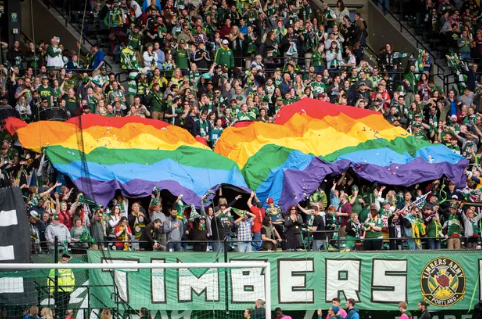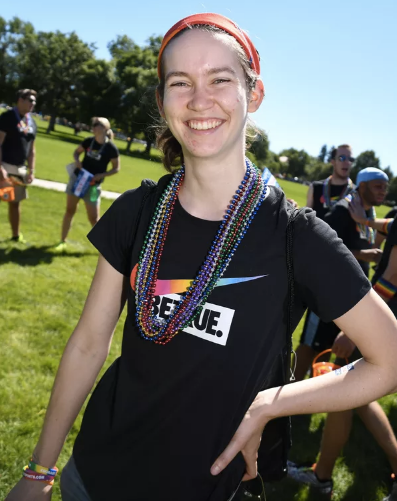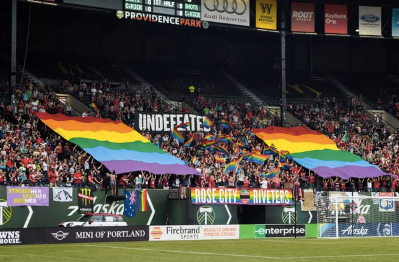This article originally appeared on Outsports

The sports commentator/radio shock jock Dino Costa was hired earlier this summer by KXTG: The Game in Portland, my adopted home. Costa is well-known for his unshakeable, 1950s-era belief that women don’t belong in sports radio. And as if choosing one absurd hill to die on wasn’t enough, shortly after he arrived in Portland, he chose to take to the airwaves and say this:
“Why is it people feel the need to show up at Timbers games... and wave a flag that identifies their sexuality?... The homosexual and lesbian community throughout the world wants to be accepted as normal, as just like everybody else... Then why the need to show up at Providence Park or any stadium, ballpark, or arena anywhere in the country and wave the—what do they call it? Gay pride flag. Why? What is up with that?... I’ve been to two Timbers games, and at both Timbers games, plenty of those flags were being waved. Why? Why aren’t you waving a Timbers flag?... What is the purpose of this? To show up at a game to wave a flag to let people know you live an alternative lifestyle? Is that what this is about?... If there was a heterosexual flag and I showed up at Providence Park and waved my heterosexual flag... Would anybody look at me sideways? Cross-eyed? I don’t get it. I just don’t get it.”
This rant, to say nothing of Costa’s other bad opinions, was the subject of a lot of discussion among Timbers supporters. To the large contingent of queer soccer fans in Portland, this feels like a special kind of assault. Costa isn’t from here, he doesn’t know the first thing about the soccer community here, and yet he’s been granted a citywide platform from which to broadcast his views.
It’s a mistake, though, to forget how many people, even in Portland, agree with him. It remains important to combat this narrative whenever we see it. To that end, I want to tell you about how much those rainbow flags have meant to me in my time in Portland.
Before I say anything about myself, I want to point out what should be an obvious truth, but somehow isn’t anymore, which is that Pride was born during a time when LGBTQ people were almost universally subjected to physical danger simply for living their lives. Pride happened because of police beatings, and hate crimes, and conversion therapy, and sodomy laws, and the Reagan administration laughing about the AIDS epidemic. I could go on. We are better off today, at least in pockets of the world — personally, I’m extremely fortunate to have never been subjected to that kind of persecution — only because queer people took to the streets and demanded visibility and safety. That’s why we get special flags. On to my story:
I’ve lived in western Oregon my whole life. It’s a pretty tolerant place, when it comes to queer folks (heads up: “queer” is the term I’m going to use instead of “homosexual and lesbian”—which happens to be a tautology, but no worries). I went to a small college in Portland where, as a friend of mine once said to the parent of a prospective student, being gay is “so fine we don’t even talk about it.”
In some sense, that’s good. I think, in a perfect world, it might be what we’d want — to be seen everywhere, as Costa says, as “normal, as just like everybody else.” Being queer would be so accepted and commonplace we wouldn’t have to come out of the closet, because there wouldn’t be a closet.
But we don’t live in that perfect world. In our world, by the time I got to college, I’d already spent 18 years internalizing the message that there was something wrong with who I was because I didn’t like wearing dresses and most of my friends were boys and I’d been getting girl crushes since age 4. That I learned these were things to hate about myself in spite of my parents having gay friends and family members, and my high school being the kind of place that staged productions of The Laramie Project and Rent, should say a lot about how deeply damaging it is to grow up in a community that does openly reject people like you.
I spent my college years with one foot in the closet. I didn’t lie about being queer, but I wasn’t forthcoming about it, either. Around masculine-presenting women, I would have quiet internal freak-outs. I tried to maintain a veneer of “normal” gender presentation, accepting who I was only grudgingly. Just because I liked girls didn’t mean I was that kind of gay (besides, sometimes I liked boys, too, so I barely even counted as queer!). This was just one thing about me. It wasn’t who I was.
I was out of college before I figured out that to accept myself, I was going to have to accept that no, I’m not just like everybody else. More important, this is who I am — or at least a really big, really central part of who I am. I learned that it’s impossible not to hate yourself if you’re constantly trying to minimize part of your identity.
And learning to accept yourself isn’t the type of thing you can do passively. You have to learn to be proud of it. You have to genuinely feel, deep in your guts, that the ways you’re different from most people aren’t just OK, but cool and good, and that for you, it’s better to be queer than not. That’s how you start to undo decades of internalized bullshit about the way you’re supposed to feel and talk and move through the world.

All queer people — every single last one of us, whether we come from San Francisco or Arkansas or Chechnya — we all have that internalized bullshit. It comes in varying degrees, certainly, and I don’t want to minimize the real-life danger and discrimination many LGBTQ people still face every day. But self-loathing is as universal an experience for queers as being on the receiving end of sexual harassment is for women.
I have a lot of people to thank for the long, still-ongoing process of learning to believe I’m good the way I am. A lot of it, though, has been soccer.
Unlike most sports fandoms anywhere in the world, the soccer scene in Portland is gay as hell. The Timbers were the first major professional sports team in the US to officially endorse gay marriage.Portland was a hotbed of women’s soccer weirdos, who cheered the University of Portland Pilots to two national championships long before the Thorns, our beloved NWSL team, were a thing (and if you got worked up about the number of rainbows in the crowd at a Timbers game, you don’t want to be around when the Thorns are playing).
And it was that culture of acceptance that hooked me.
The day I fell hopelessly in love with Portland soccer was one fall — I would have been 22 — when I was watching an Oregon Ducks football game at a sports bar in Portland. I grew up in Eugene, with Ducks fandom as a birthright. As if to tell me I didn’t belong there, this bald-headed beefcake at the bar that day kept throwing around the word “faggot,” as deftly as Marcus Mariota was throwing touchdown passes on the projector screen in front of us.
It wasn’t directed at me, of course. But any time I hear language like that, this is the message: Your right to feel safe is less important than my right to act like a bloviating ass. You don’t matter. If this hurts or scares you, you should hide.
A friend was watching a Thorns game (in fact, it was the 2013 NWSL championship) at a different bar, so midway through the Ducks game, I went to hang out with him. The bar was packed from wall to wall with people in Thorns and Timbers jerseys, scarves draped around every neck, many of them adorned with rainbows.
Any time I see a room full of sports fans wearing rainbows, this is the message: You’re welcome here. I see you. You matter.
What I felt in that moment, much like falling in love with a person, wasn’t any big, dramatic revelation. It was a quiet realization: “Oh. This is for me.” (A big, dramatic revelation of a different kind came in the 40th minute, when Tobin Heath did this).
People had packed this place to watch a women’s soccer team — our women’s soccer team — fight for a title, and be as gay as they wanted to while doing it. Nobody had to check their identity at the door.
In the college football scene I’d just left, and in most mainstream sports fandoms, the message, at best, is that it’s OK to be gay as long as you shut up about it.
And that begrudging tolerance is Costa’s attitude. When he says “the homosexual and lesbian community throughout the world wants to be accepted as normal, as just like everybody else,” he’s not saying that because people from my community have told him that. It’s an assumption he’s making. Why wouldn’t we want to blend in with everybody else?
But the fact is, that’s not what we want. That’s what he wants. He can tolerate the thought of people living an “alternative lifestyle” as long as we act “normal” while we do it.
There is simply no way to undo the self-loathing I talked about earlier while maintaining a belief that it’s important to act “normal,” or trying not to rub gayness in straight people’s faces.
That’s why soccer in Portland has been a home for me. The Thorns community, in particular, is the first space I’d ever been part of where being queer and a woman isn’t merely allowed, but cool and good. It’s hard to overstate how important that is. Community has long been literally vital for LGBTQ people, and if that’s somewhat less true in Portland in 2017 than it was in New York in 1969, it’s precisely because queer communities have existed for long enough.
You will hear beautiful stories, if you talk to people in the North End, about folks finding their second families there. I don’t have one of those stories, but over the last few years, as I’ve gotten deeper and deeper into covering the Thorns as a reporter, I’ve become part of that community, in a small way. That I belong there is never in question. As other queer and female sports reporters know too well, that’s a rare, special thing in sports.
I’ve felt a variety of emotions in Providence Park: the giddy joy of watching the Timbers dismantle Seattle, the agony of the Thorns falling to Western New York in last year’s NWSL semifinal. As long as I live, I’ll never forget witnessing the act of God that caused Saad Abdul-Salaam’s penalty kick to bounce off both goalposts in the 2015 MLS playoffs. I think the only time I’ve ever been close to actual tears, though, was when supporters unveiled this tifo at a 2016 Thorns game:

